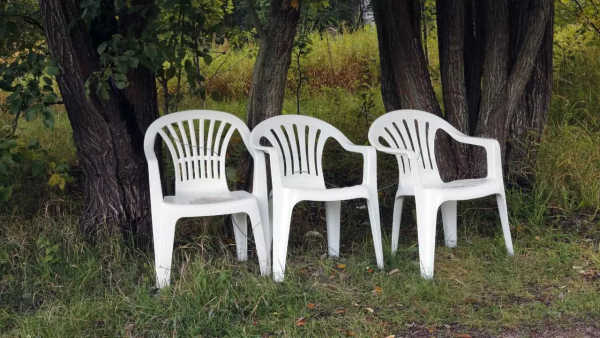
That white or brown plastic chair you’ve sat on at weddings, tuition centres, railway stations, or even while sipping chai at the local shop has a quirky little detail – a hole at the back. We’ve all leaned on it, maybe even peeked through it as kids, but hardly anyone stops to think why it’s there. It’s not just some random design choice or a cheap shortcut by manufacturers. That little cut-out actually hides some smart engineering that makes the humble plastic chair safer, sturdier, and more useful than it looks.
In this article, we’ll break down the reason behind plastic chairs with a hole at the back, explore the clever functions it serves, and explain why this design has stayed the same for decades in India and beyond. Once you know the reasons, you’ll never look at these chairs the same way again.
Plastic chairs with a hole at the back improve air circulation
One of the most practical reasons behind the hole in plastic chairs is air circulation. When you sit for long periods, especially in hot and humid Indian weather, your back can get sweaty and uncomfortable. The cut-out provides a natural air passage that allows ventilation, keeping you cooler and less sticky. This is especially handy in large gatherings like weddings or school events where people sit for hours. A small design tweak ensures maximum comfort without any extra cost.
Plastic chairs with a hole at the back reduce structural stress

Plastic chairs may look lightweight, but they have to carry heavy loads. Without the hole, the backrest would be a single solid piece that’s more likely to crack under pressure. The gap distributes stress evenly across the frame, giving the chair more flexibility and strength. It essentially prevents breakage by reducing the chances of fractures at the weakest points. That’s why even though these chairs are cheap, they can last for years if handled properly.
Plastic chairs with a hole at the back help in stacking and storage
Ever noticed how easy it is to stack a dozen plastic chairs neatly on top of each other? The hole at the back plays a big role in that. When chairs are stacked, the air trapped between them escapes through the hole, preventing a vacuum effect that makes chairs stick. This ensures smooth stacking and unstacking, which is a blessing for event organisers, caterers, and households with limited storage space. It’s one of the simplest yet most effective design hacks.
Plastic chairs with a hole at the back make cleaning easier

In India, where dust, food crumbs, or even rain can dirty furniture, ease of cleaning matters. The cut-out allows water and soap to flow through easily, making washing faster and more effective. If the back were completely solid, water would collect in corners, leaving stains or marks. With the hole, plastic chairs stay fresh-looking with minimal effort, which is one reason they are so popular in homes, offices, and public places.
Plastic chairs with a hole at the back prevent accidents
The hole is not only about convenience but also about safety. In case the chair tips backward, the gap reduces the suction effect against the floor, making it easier for air to pass through. This lowers the impact of a fall and reduces the chances of serious damage to the chair or injury to the person sitting. It’s a subtle but significant safety feature that most people don’t realise.
Plastic chairs with a hole at the back add to design flexibility
Manufacturers also use the hole to play with design. The cut-out allows for variations in shape and size, giving chairs a slightly different look while keeping costs low. From the classic oval shape to modern square or designer cuts, the hole ensures that plastic chairs remain practical but also stylish in their own way. This flexibility in design has made them timeless pieces of furniture that fit everywhere, from middle-class Indian homes to luxury resorts.
The hole in plastic chairs is proof that good design doesn’t need to be flashy. A small, simple detail can serve multiple purposes – comfort, strength, safety, and convenience. That’s why even after decades, plastic chairs across India and the world look almost identical. They remain affordable, easy to maintain, and extremely durable, making them a permanent part of our daily lives.
Also read|
6 practical ways to use carrot peels for health and home
 That white or brown plastic chair you’ve sat on at weddings, tuition centres, railway stations, or even while sipping chai at the local shop has a quirky little detail – a hole at the back. We’ve all leaned on it, maybe even peeked through it as kids, but hardly anyone stops to think why it’s there. It’s not just some random design choice or a cheap shortcut by manufacturers. That little cut-out actually hides some smart engineering that makes the humble plastic chair safer, sturdier, and more useful than it looks.
That white or brown plastic chair you’ve sat on at weddings, tuition centres, railway stations, or even while sipping chai at the local shop has a quirky little detail – a hole at the back. We’ve all leaned on it, maybe even peeked through it as kids, but hardly anyone stops to think why it’s there. It’s not just some random design choice or a cheap shortcut by manufacturers. That little cut-out actually hides some smart engineering that makes the humble plastic chair safer, sturdier, and more useful than it looks.

